The Tribometer Market is estimated to be valued at USD 316.5 million in 2025 and is projected to reach USD 540.6 million by 2035, registering a compound annual growth rate (CAGR) of 5.5% over the forecast period.
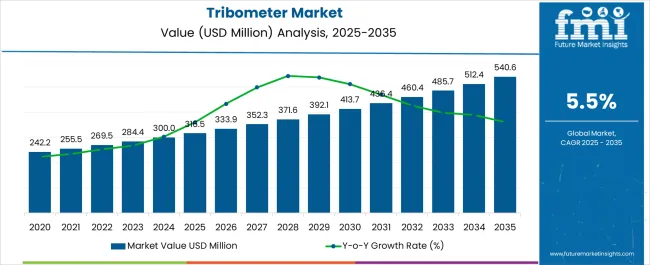
| Metric | Value |
|---|---|
| Tribometer Market Estimated Value in (2025 E) | USD 316.5 million |
| Tribometer Market Forecast Value in (2035 F) | USD 540.6 million |
| Forecast CAGR (2025 to 2035) | 5.5% |
The Tribometer market is experiencing steady growth due to the increasing emphasis on friction, wear, and lubrication analysis across various industries. Tribometers are essential for testing material durability, optimizing surface coatings, and improving mechanical performance, which has amplified demand in automotive, aerospace, and industrial applications. The current market is driven by rising investments in research and development for advanced materials and high-performance components, alongside the adoption of stringent quality and safety standards.
With industries focusing on reducing maintenance costs, improving energy efficiency, and extending equipment lifespan, tribometer usage has become indispensable. The market is further shaped by advancements in testing methodologies, automated measurement systems, and integration with digital data acquisition, enabling more precise and reproducible results.
Future opportunities are expected to arise from increasing adoption of non-metallic materials, nanomaterials, and bio-based lubricants, where detailed tribological characterization is critical As manufacturing industries continue to evolve, the demand for tribometers to ensure product reliability and performance is anticipated to maintain a strong upward trajectory.
The tribometer market is segmented by type of tribometer, application, material type, end-user, technology, and geographic regions. By type of tribometer, tribometer market is divided into Pin-On-Disk Tribometer, Ball-On-Disk Tribometer, Reciprocating Tribometer, and Rotary Tribometer. In terms of application, tribometer market is classified into Automotive Industry, Aerospace And Defense, Manufacturing And Industrial Applications, Medical Devices, and Research And Development. Based on material type, tribometer market is segmented into Metallic Materials, Polymeric Materials, Ceramic Materials, and Composite Materials. By end-user, tribometer market is segmented into Academic And Research Institutions, Manufacturers And Suppliers, Quality Control And Assurance Departments, Consulting And Advisory Services, and Government And Regulatory Agencies. By technology, tribometer market is segmented into Mechanical Tribometers, Optical Tribometers, Electrochemical Tribometers, and Micro And Nano Tribometers. Regionally, the tribometer industry is classified into North America, Latin America, Western Europe, Eastern Europe, Balkan & Baltic Countries, Russia & Belarus, Central Asia, East Asia, South Asia & Pacific, and the Middle East & Africa.
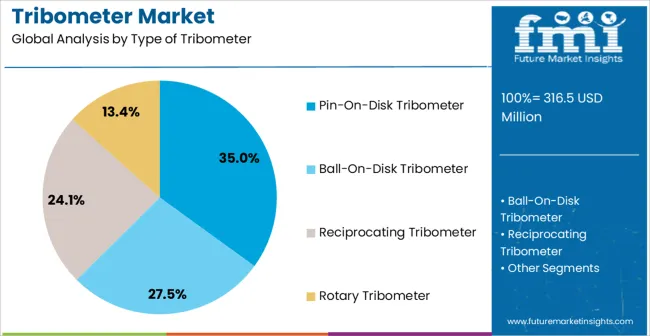
The Pin-On-Disk Tribometer type is projected to hold 35.00% of the Tribometer market revenue share in 2025, making it the leading type. Its dominance is attributed to its simple design, high precision, and versatility in evaluating friction and wear properties under controlled conditions. The segment’s growth has been supported by extensive adoption in laboratory testing and industrial quality assurance, where accurate surface interaction measurements are critical.
The ability to simulate real-world operating conditions, including varying loads, speeds, and environmental factors, has reinforced its preference over other tribometer types. Furthermore, the ease of data acquisition, reproducibility of results, and cost-effectiveness for long-term testing projects have further enhanced its market position.
Industries seeking reliable and standardized testing solutions have contributed to the continued growth of the Pin-On-Disk segment As the demand for high-performance components increases, this segment is expected to maintain leadership by providing scalable, accurate, and software-compatible tribological testing solutions.
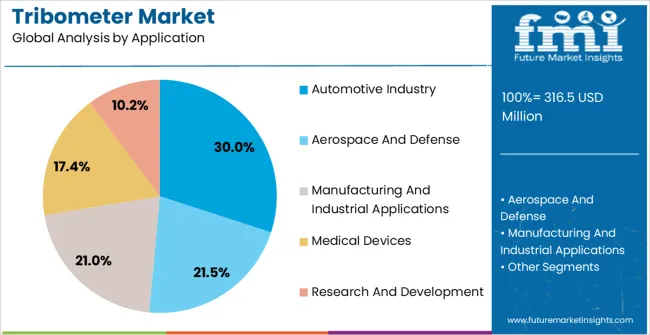
The Automotive Industry segment is anticipated to account for 30.00% of the Tribometer market revenue in 2025, making it the leading application sector. Its growth is being driven by the increasing need for friction and wear analysis in vehicle engines, transmission systems, braking components, and tire-road interactions. Tribometers are extensively used to optimize material selection, reduce energy loss, and improve component longevity, which is essential in meeting stringent emission and fuel efficiency standards.
The rise of electric vehicles and hybrid systems has further amplified the demand for precise tribological characterization to enhance battery components and lightweight materials. Continuous innovation in automotive materials and coatings has created a strong requirement for tribometer-based testing to ensure product reliability under diverse operating conditions.
The growing focus on safety, performance, and durability in automotive components has reinforced this segment’s market dominance As automotive manufacturers prioritize advanced materials and sustainable solutions, the segment is expected to maintain a leading position by providing critical insights into wear mechanisms and material behavior.
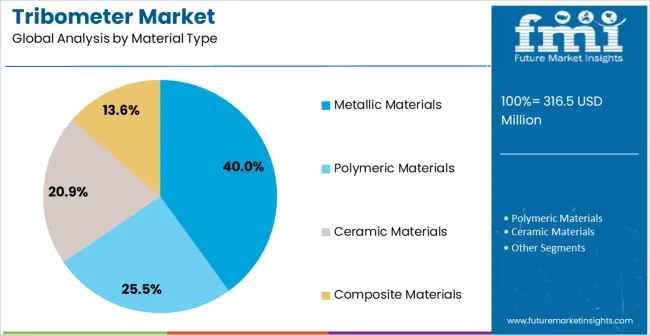
The Metallic Materials segment is projected to hold 40.00% of the Tribometer market revenue share in 2025, emerging as the largest material type segment. This leadership is being attributed to the widespread use of metals in industrial components, machinery, and automotive applications where friction, wear, and lubrication directly influence performance. The growth of this segment has been supported by the need to optimize surface coatings, reduce wear rates, and extend equipment life across sectors including manufacturing, aerospace, and automotive.
Metallic materials require precise tribological evaluation to ensure safety, efficiency, and cost-effective operation in high-stress environments. Advancements in metallurgical engineering, heat treatment processes, and coating technologies have increased the reliance on tribometer testing for material validation.
The segment has benefited from the critical role that metals play in supporting structural integrity, reliability, and performance across multiple applications With increasing adoption of high-strength alloys and specialty metals, metallic materials are expected to continue leading the Tribometer market due to their fundamental importance in industrial and automotive sectors.
Tribometer is an instrument that measures quantities such as wear volume, friction force and coefficient of force between two contact surfaces. Tribometer are used to test and analyze the long-term performance and function various devices. The requirement of controlling wear and friction in movable devices or machine parts is very important in the industry. Tribometer also measures single wear friction with liquid, temperature and atmosphere control options.
Tribometer are widely used in different industries such as aerospace, machining, automotive, environmental, biomedical, and other industries for various application and testing of appliances.
Tribometer market is anticipated to grow due to its wide application in automotive and aerospace industry for testing of machinery. Moreover, it is projected to grow with a single digit CAGR in the forecast period, 2025-2035.
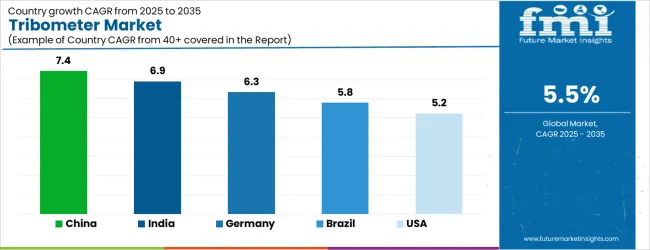
| Country | CAGR |
|---|---|
| China | 7.4% |
| India | 6.9% |
| Germany | 6.3% |
| Brazil | 5.8% |
| USA | 5.2% |
| U.K. | 4.7% |
| Japan | 4.1% |
The Tribometer Market is expected to register a CAGR of 5.5% during the forecast period, exhibiting varied country level momentum. China leads with the highest CAGR of 7.4%, followed by India at 6.9%. Developed markets such as Germany, France, and the U.K. continue to expand steadily, while the U.S. is likely to grow at consistent rates. Japan posts the lowest CAGR at 4.1%, yet still underscores a broadly positive trajectory for the global Tribometer Market. In 2024, Germany held a dominant revenue in the Western Europe market and is expected to grow with a CAGR of 6.3%. The U.S. Tribometer Market is estimated to be valued at USD 116.7 million in 2025 and is anticipated to reach a valuation of USD 116.7 million by 2035. Sales are projected to rise at a CAGR of 0.0% over the forecast period between 2025 and 2035. While Japan and South Korea markets are estimated to be valued at USD 15.0 million and USD 10.9 million respectively in 2025.
<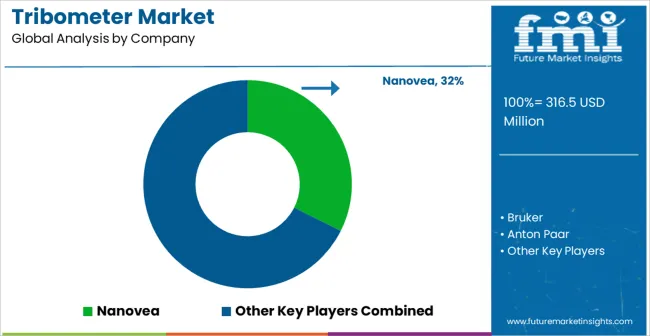 ul>
ul>
| Item | Value |
|---|---|
| Quantitative Units | USD 316.5 Million |
| Type of Tribometer | Pin-On-Disk Tribometer, Ball-On-Disk Tribometer, Reciprocating Tribometer, and Rotary Tribometer |
| Application | Automotive Industry, Aerospace And Defense, Manufacturing And Industrial Applications, Medical Devices, and Research And Development |
| Material Type | Metallic Materials, Polymeric Materials, Ceramic Materials, and Composite Materials |
| End-User | Academic And Research Institutions, Manufacturers And Suppliers, Quality Control And Assurance Departments, Consulting And Advisory Services, and Government And Regulatory Agencies |
| Technology | Mechanical Tribometers, Optical Tribometers, Electrochemical Tribometers, and Micro And Nano Tribometers |
| Regions Covered | North America, Europe, Asia-Pacific, Latin America, Middle East & Africa |
| Country Covered | United States, Canada, Germany, France, United Kingdom, China, Japan, India, Brazil, South Africa |
| Key Companies Profiled | Nanovea, Bruker, Anton Paar, Advanced Mechanical Technology, and Rtec Instruments |
The global tribometer market is estimated to be valued at USD 316.5 million in 2025.
The market size for the tribometer market is projected to reach USD 540.6 million by 2035.
The tribometer market is expected to grow at a 5.5% CAGR between 2025 and 2035.
The key product types in tribometer market are pin-on-disk tribometer, ball-on-disk tribometer, reciprocating tribometer and rotary tribometer.
In terms of application, automotive industry segment to command 30.0% share in the tribometer market in 2025.






Our Research Products

The "Full Research Suite" delivers actionable market intel, deep dives on markets or technologies, so clients act faster, cut risk, and unlock growth.

The Leaderboard benchmarks and ranks top vendors, classifying them as Established Leaders, Leading Challengers, or Disruptors & Challengers.

Locates where complements amplify value and substitutes erode it, forecasting net impact by horizon

We deliver granular, decision-grade intel: market sizing, 5-year forecasts, pricing, adoption, usage, revenue, and operational KPIs—plus competitor tracking, regulation, and value chains—across 60 countries broadly.

Spot the shifts before they hit your P&L. We track inflection points, adoption curves, pricing moves, and ecosystem plays to show where demand is heading, why it is changing, and what to do next across high-growth markets and disruptive tech

Real-time reads of user behavior. We track shifting priorities, perceptions of today’s and next-gen services, and provider experience, then pace how fast tech moves from trial to adoption, blending buyer, consumer, and channel inputs with social signals (#WhySwitch, #UX).

Partner with our analyst team to build a custom report designed around your business priorities. From analysing market trends to assessing competitors or crafting bespoke datasets, we tailor insights to your needs.
Supplier Intelligence
Discovery & Profiling
Capacity & Footprint
Performance & Risk
Compliance & Governance
Commercial Readiness
Who Supplies Whom
Scorecards & Shortlists
Playbooks & Docs
Category Intelligence
Definition & Scope
Demand & Use Cases
Cost Drivers
Market Structure
Supply Chain Map
Trade & Policy
Operating Norms
Deliverables
Buyer Intelligence
Account Basics
Spend & Scope
Procurement Model
Vendor Requirements
Terms & Policies
Entry Strategy
Pain Points & Triggers
Outputs
Pricing Analysis
Benchmarks
Trends
Should-Cost
Indexation
Landed Cost
Commercial Terms
Deliverables
Brand Analysis
Positioning & Value Prop
Share & Presence
Customer Evidence
Go-to-Market
Digital & Reputation
Compliance & Trust
KPIs & Gaps
Outputs
Full Research Suite comprises of:
Market outlook & trends analysis
Interviews & case studies
Strategic recommendations
Vendor profiles & capabilities analysis
5-year forecasts
8 regions and 60+ country-level data splits
Market segment data splits
12 months of continuous data updates
DELIVERED AS:
PDF EXCEL ONLINE

Thank you!
You will receive an email from our Business Development Manager. Please be sure to check your SPAM/JUNK folder too.
Chat With
MaRIA